Being Theoria: The Fourth Hangzhou Fiber Art Triennial Zhejiang Art Museum
| June 5, 2023
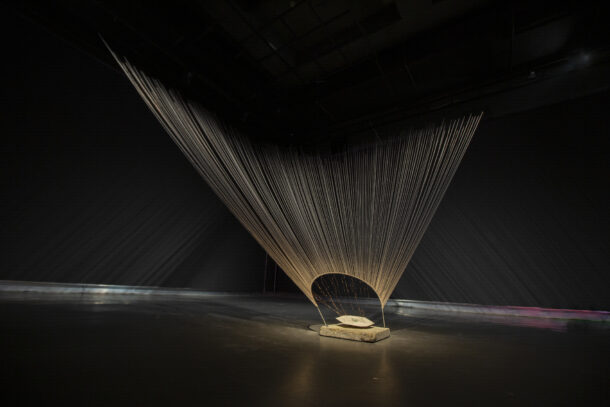
Constanza Piña, Khipu: Electrotextile Prehispanic Computer, 2018, alpaca wool, copper wire, electronic circuit, 250 × 500 × 500 cm
Courtesy the artist and the 4th Hangzhou Triennial of Fiber Art
After three years, in the aftermath of the pandemic, the “Fourth Hangzhou Triennial of Fiber Art” (hereafter referred to as “Fiber Three”) finally debuted. The “knowledge production” and “interpretation of fiber” illustrates the intellectual tendency of the exhibition and the works in structure. This tendency responds to the global trend of contemporary art while also leaving a significant trace in the coordinates of the Chinese context. At the same time, the related practice of the exhibition also highlights issues that are yet to be resolved.
The name of this triennial is “Being Theoria.” The curatorial team tries to redefine art in this way: “the way of creation and existence of ‘art’ is a kind of ‘cache’ that is yet to be finalized.” As such, the exhibition is divided into nine sections (or sub-projects)—each connects to others in an entangled network—to “see fiber as the basic structure of the world and the prototype and metaphor of human thought.” The concept and structure of the exhibition are derived from a genealogical examination of related Chinese characters, as they are regarded as the way our ancestors interacted with the world around them. Some of the works in the exhibition are presented as both artworks and everyday objects, both document display and knowledge production. The most representative ones include Ten Thousand Things: Origins of Fiber at the entrance, as well as documents that are scattered throughout the exhibition and share an intertextual relationship with the works and the show (such as Heraclitus Fragments, Shuowen Jiezi, and General Morphology of Organisms). If we say that they represent the macrostructure of the exhibition based on a system of knowledge, then individual works form their own (and between works) microstructures through their internal, epistemological investigations. The classic texts in these structures, production techniques, industrialized processes of production, and the way they are considered to have constructed the world constitute an overall feature of this triennial: intellectualization. (This process) allows art (methods, ways of display, and frameworks of meaning) to intersect with the broader subject—the folk contexts, which expresses the “knowledge” of an artist in the form of “knowledge.
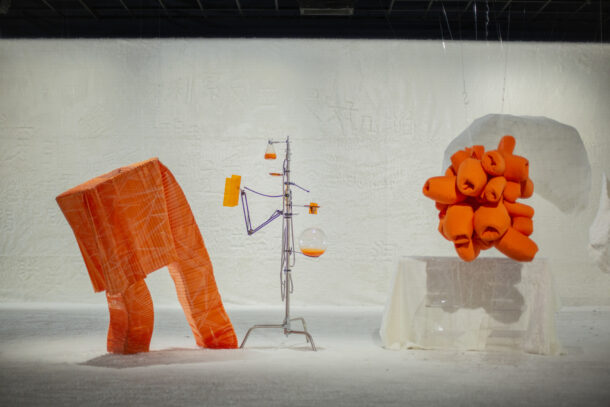
Huang Ying, Chen Yue, Li Danlin, Hydrogen Peroxide, 2022,
air-layered fabric, cotton, dupont paper, metal stand, acrylic, variable dimensions
Similarly, the intellectualization of contemporary art has its historical roots. The power reserve of higher education in art, the system of discourse that crosses disciplinary boundaries, and the rise of the knowledge economy (creative industry) on a global scale, are all basic conditions of this year’s “Fiber Three” that (enables it) to situate itself within a Chinese context and responds to the global art world. Therefore, “Fiber Three” illustrates the strength of the academy in terms of the creation, display, dissemination, circulation, interpretation, and even perception of art—if not named an “academic school.” It is foreseeable that this type of academic power that has emerged on a global scale will continue to grow in the years to come; what is related is the function of “producing knowledge” of art in this process, even though it is subject to controversy.
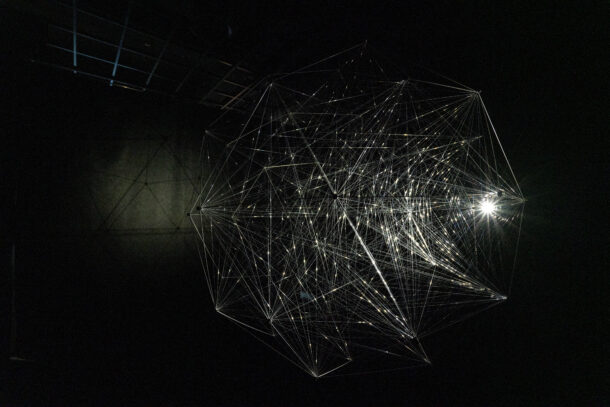
Ivana Franke, Knowledge of Fireflies, 2022, installation in a dark space, spherical metal construction, monofilament, one motor, three light bulbs, two control units, 120 × 120 × 120 cm
This year’s “Fiber Three” presents at least three modes of “knowledge production.” Firstly, the “illustration” type, which directly presents the existing “knowledge” as production or material for creation. Secondly, the relatively common “appropriation- interpretation” type, whether it involves existing texts or technical realities (such as Study of a Poem by Rainer Maria Rilke and Khipu: Electrotextile Prehispanic Computer). (These works) all refer to, mention, or quote ready-made subjects or texts. Thirdly, let’s call it the “future production type that is to be interpreted” with examples such as Flag Series From My Terrace During Covid19 Pandemic and Re-encode: Pattern. In addition (to the three modes), structurally, the exhibition presents the composition and operation of the world through nine sections. Therefore, in the process of repositioning “art” in this cognitive perspective, the exhibition reflects the overall characteristic of “intellectualization” and knowledge production.
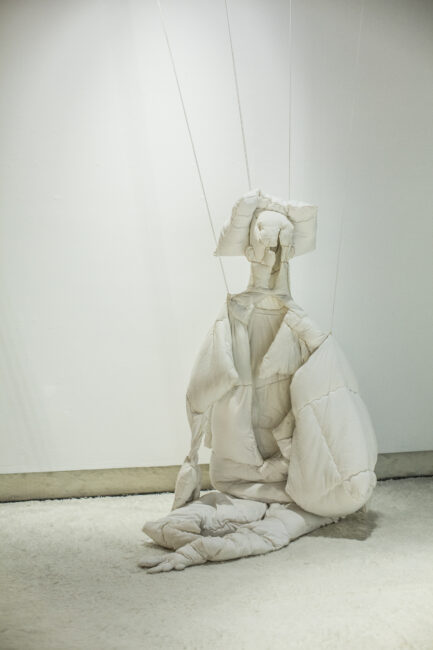
Liu Tiantong, White Quilt, 2022,
white quilt and cotton, variable dimensions
From the perspective of the global trend of intellectualization, “Fiber Three” is synchronized with it but has parts that are not synchronized (or unable to be synchronized). The “intellectualization” traces back to Aby Warburg and spreads through the interdisciplinary discourses that includes critical theory and power analysis in the mid- and late twentieth century. This idea became a core component of art, along with “dematerialization/ conceptualization.” The classic intellectualization entails reconsidering the conditions of “the formation of knowledge”: how did existing classifications of knowledge form, and whether these categorizations define and limit the way we “perceive” the world? So, are there other possibilities? From this point of view, art is becoming an entity that is about “knowledge” from one that emphasizes existence, perception, and labor/skills. As such, it is not surprising that the subject (and its forms), individuals and the collective, categories (or methods) of social practices and relations become the core elements—whether explicit or implicit—of both the “Fiber Three” and a larger global trend.
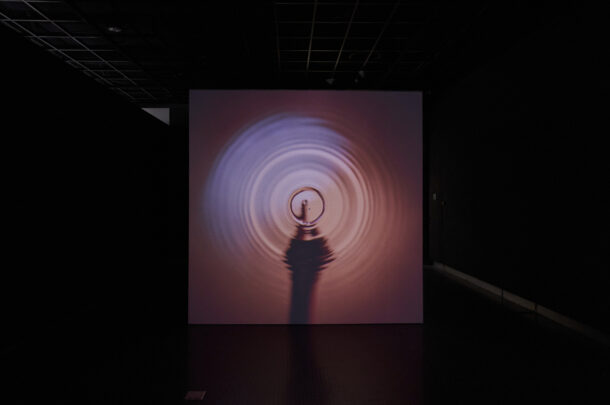
Chen Zhe, You Are a Circle, Expanding (So Below), 2021, video, 7 minutes 40 seconds
Courtesy the artist and the 4th Hangzhou Triennial of Fiber Art
On the question of synchronicity and asynchronicity, the artistic context of contemporary China obviously does not have the conditions to transform this “intellectualization” into a more serious or rigorous “art research.” As far as the curatorial practice of this triennial, the exhibition has joined the ranks of “intellectualization” but has only sampled the so-called “research.” The more ideal “art research” tries to experiment with methods and diversify the knowledge in order to propose new ways of being in the world through its entanglement with materials. As far as the exhibition and the works of art are concerned, “Fiber Three” has not reached that stage yet.
In recent years, the practice and display of contemporary Chinese art has expanded the romantic tendency to strengthen personal feelings. This trend manifests itself in practices that assume the magnified, personal feelings as universal. For example, curators use what they think is an “impartial” perspective to articulate artistic expressions that are based on regions, groups, or generations. This laid the groundwork for the implosion of exhibitions and practices that use the name of “research” and exaggerated the exchange value of “research” in contemporary Chinese art, revealing the tendency for Chinese art to resonate with the global trend of intellectualization (or knowledge economy) and its historical origins. Although we can attribute these to the structural debts, unique realistic soil, and changeable historical revolution of contemporary Chinese art, these external reflections will inevitably miss out on the internal roots of this type of phenomena.
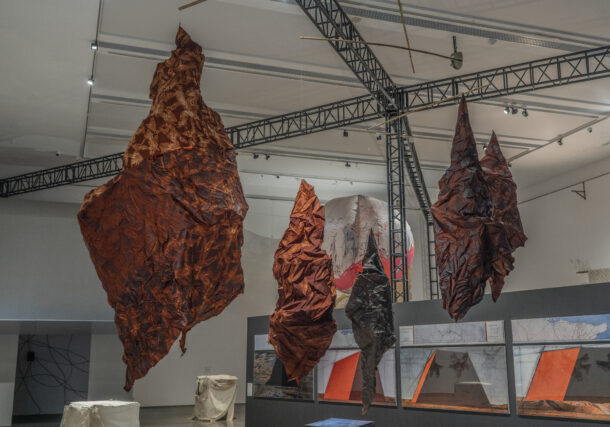
Kathrin von Rechenberg, Shuliang-Cocoon, 2021, raw silk, variable dimensions
Courtesy the artist and the 4th Hangzhou Triennial of Fiber Art
On the one hand, this kind of phenomena extend the basic logic of the avant-gardes of Chinese modernism—equating individual feelings with the freedom of self-determination. On the other hand, the successors have to face the world after their predecessors broke the “world picture” with this logic. In this regard, “Fiber Three” shows an intellectualization that breaks through the trends of atomization and subjunctivization in the aforementioned phenomena and utilizes the woven networks as a metaphor for the “knowledge” of art, as well as the world and the “recognition” of existence. In other ways, the large number of vocabulary throughout the exhibition (for example, “webs,” “weaving,” “knots,” “connection,” “organization,” and “system”) all hints at this basic understanding. Perhaps it is precisely because of this, the first floor of the exhibition—with general and accessible mediums, spatial arrangements, concerns and methods of organization—presents the most diverse and abundant façade over the past years. This is the inevitable result of knowledge production and the natural fruit of the transformation of method.
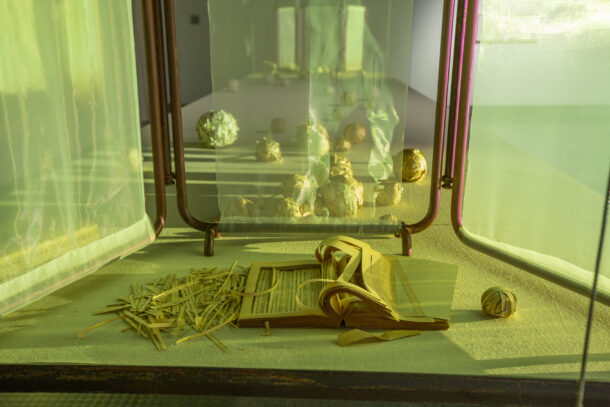
Ann Hamilton, Pages, 2022, unique cloth and word collage on book and papers, 20.32 × 12.7 cm on paper, 42.55 × 35.24 × 3.2 cm with frame
Courtesy the artist and the 4th Hangzhou Triennial of Fiber Art
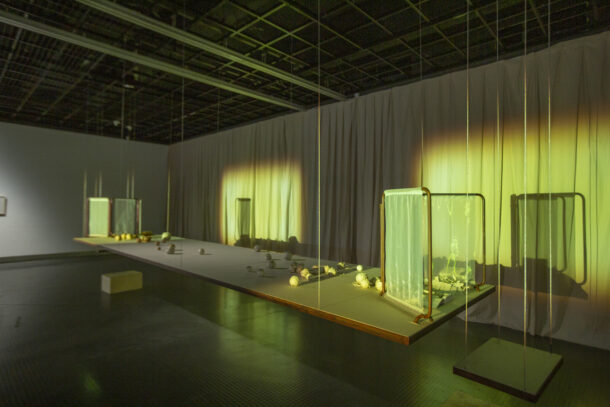
Ann Hamilton, lineament, 2022, ball wound from strips of text, book,
wood, cloth, variable dimensions
Courtesy the artist and the 4th Hangzhou Triennial of Fiber Art
However, the diversified knowledge production of this year’s triennial is more about explaining fiber art through the weaving of knowledge that is not based in the medium (of fiber) itself. As a way of interpretation, “Fiber Three” successfully presents the practice that is in the matrix relationship of creation, materials/ mediums, and cognition. The exhibition also leaves unresolved questions due to the intellectualization of art. Firstly, the intellectualization of art bases itself upon the questioning of existing classification and categorization of knowledge to generate more possibilities for “cognition,” but it will eventually point to the epistemological question of “what constitutes the cognition of art” and connects with the ontology of art like “who counts as a subject.” These questions naturally lead to considerations related to the existence of art beyond the “fiber of interpretation” of this triennial: what is the relationship between the production of knowledge that concerns itself with the “cognition of art” and the audience? Perhaps, questions are open, as we look forward to another edition of “Fiber Three” in three years.
Dr.Zhang Zhongtao is a researcher at the China Academy of Art, specializing in contemporary art and the philosophy of art.
Translated by Yupeng Wu


